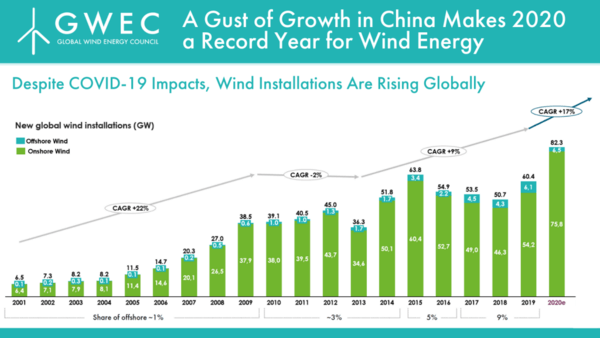News Release from windfair.net
Wind Industry Profile of
China Causes a Stir
Last week, the responsible Chinese authority, together with the Danish Energy Agency, with which China has been cooperating since 2005, presented the expansion figures for 2020: According to these, China expanded a global record 120 gigawatts of wind and solar energy last year. The figures suggest that the country is well on its way to achieving its self-imposed climate target of 1200 GW by 2030 - given that a further annual expansion of a similar amount will be implemented.
Elsewhere, however, these figures from China are causing frowns, as Greentech Media reports. The medium, belonging to analysis company Wood Mackenzie, quotes its senior analyst Xiaoyang Li, who is surprised at the actual magnitude of the expansion. Though China experts had expected big numbers in 2020, the magnitude now indicated defies all predictions. The International Energy Agency had predicted that the country would add about 32 GW of wind power and 50 GW of solar energy, while BloombergNEF expected 36 GW each of new solar and wind energy capacities and still saw a possibility for 40 GW in PV additions.
Now the official figure for photovoltaics was as high as 48 gigawatts. "The solar number is kind of explainable, or at least within imagination," Beijing-based BloombergNEF analyst Jonathan Luan Dong said in an interview, because year-end installation peaks are normal for the market, "especially over the past couple of years when there’s [been] a tariff drop after the end of the year."

Chinese figures provide a big boost to wind power expansion (Graphic: GWEC)
The wind numbers, on the other hand, blow everything away. The Chinese authority reported nearly 72 GW of new wind capacity in 2020, which is more than the Global Wind Energy Council had expected for the entire world.
"December activity alone may have topped 47 GW, which is higher than the total Chinese wind capacity additions from 2018 and 2019 combined," said a surprised Li (Wood Mackenzie). Various analysts therefore have doubts about the accuracy of these figures, as they also don't match on-site observations.
Installing 47 GW in one month alone would have created serious supply chain bottlenecks, according to Luan. But there's little evidence of that. Besides, in many parts of China the ground is frozen in December, so it would be difficult to carry out construction work.
So how do the high numbers come about? The experts aren't in agreement, but they suspect new calculation criteria, for one thing. Thus wind farms installed in earlier years but not yet connected to the grid could have been included in the 2020 figures, the Chinese Wind Energy Association suspects. Projects that were only partially completed last year could also have been included in the annual figures. Add to this a rapid recovery from the initial impact of the coronavirus, as China is the only major economy to have experienced economic growth during the pandemic: official figures report GDP growth of 2.3% in 2020, while domestic electricity demand from April 2020 exceeded 2019 figures, GWEC stated.
That Chinese additions could slow down in the coming years is basically not to be expected. Regardless of whether 120 or 'only' 72 GW were added, China's coal-fired power capacity will have to drop from the current level of almost 1100 to 680 gigawatts if the CO2 targets are to be met by 2030, as reported by Die Zeit. So there's still a lot to do in China.
- Author:
- Katrin Radtke
- Email:
- press@windfair.net
- Keywords:
- China, numbers, global, installation, outlook, solar, pv, report, authority, wind, expectation, GW, gigawatts, BloombergNEF, IEA, GWEC, Wood Mackenzie, Greentech Media



























